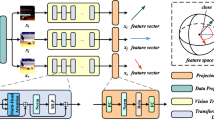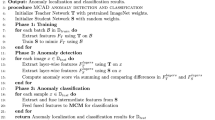Abstract
With the development of deep learning techniques, an increasing number of anomaly detection methods based on deep neural networks have been proposed during the last decade. Nevertheless, these methods often suffer from catastrophic forgetting when trained on continuously arriving data samples, as deep neural networks quickly forget the knowledge obtained from previous training while adjusting to learning new information. In this work, we propose a contrastive lifelong learning model for image anomaly detection. Rather than adopting CNN-based neural networks as in other anomaly detection approaches to learn representations from training samples, we propose a contrastive learning framework for anomaly detection in which Vision Transformer (VIT) is adopted for extracting promising representations. Two nonlinear structures (projector and predictor) are integrated into our model, which is helpful in improving the performance of anomaly detection. Moreover, a lifelong learning framework that contains teacher and student networks is deployed in our model, which is able to mitigate the problem of catastrophic forgetting in image anomaly detection. By leveraging both lifelong learning and contrastive learning frameworks, our model is able to progressively perform image anomaly detection where the problem of catastrophic forgetting can be greatly mitigated. We demonstrate the effectiveness of the proposed anomaly detection method by conducting experiments on multiple image data sets.






Similar content being viewed by others
Data Availability
The data sets analysed during the current study are available at:
– CIFAR10 and CIFAR100: http://www.cs.toronto.edu/~kriz/cifar.html
– BreakHis: https://web.inf.ufpr.br/vri/databases
– BACH: https://iciar2018-challenge.grand-challenge.org/Dataset
– MNIST: http://yann.lecun.com/exdb/mnist
– MVTec: https://www.mvtec.com/company/research/datasets/mvtec-ad
Notes
The source code of our proposed model is available at https://github.com/sutusutu/lifelong-anomaly-detection.
References
Akcay S, Atapour-Abarghouei A, Breckon TP (2018) Ganomaly: Semi-supervised anomaly detection via adversarial training. In: Asian conference on computer vision, Springer, pp 622–637
Aresta G, Araújo T, Kwok S, Chennamsetty SS, Safwan M, Alex V, Marami B, Prastawa M, Chan M, Donovan M et al (2019) Bach: Grand challenge on breast cancer histology images. Med Image Anal 56:122–139
Bergmann P, Fauser M, Sattlegger D, Steger C (2019) Mvtec ad–a comprehensive real-world dataset for unsupervised anomaly detection. In: Proceedings of the IEEE/CVF conference on computer vision and pattern recognition, pp 9592–9600
Bottou L (2010) Large-scale machine learning with stochastic gradient descent. In: Proceedings of COMPSTAT’2010, Springer, pp 177–186
Brown CD, Davis HT (2006) Receiver operating characteristics curves and related decision measures: a tutorial. Chemometr Intell Lab Syst 80(1):24–38
Chen T, Kornblith S, Norouzi M, Hinton G (2020a) A simple framework for contrastive learning of visual representations. In: International conference on machine learning, PMLR, pp 1597–1607
Chen X, He K (2021) Exploring simple siamese representation learning. In: Proceedings of the IEEE/CVF conference on computer vision and pattern recognition (CVPR), pp 15,750–15,758
Chen X, Fan H, Girshick R, He K (2020b) Improved baselines with momentum contrastive learning. arXiv:200304297
Deng J, Dong W, Socher R, Li LJ, Li K, Fei-Fei L (2009) Imagenet: A large-scale hierarchical image database. In: 2009 IEEE conference on computer vision and pattern recognition, pp 248–255
Dosovitskiy A, Beyer L, Kolesnikov A, Weissenborn D, Zhai X, Unterthiner T, Dehghani M, Minderer M, Heigold G, Gelly S et al (2020) An image is worth 16x16 words: Transformers for image recognition at scale. arXiv:201011929
Fini E, da Costa VGT, Alameda-Pineda X, Ricci E, Alahari K, Mairal J (2021) Self-supervised models are continual learners. arXiv:211204215
Fujioka T, Kubota K, Mori M, Kikuchi Y, Katsuta L, Kimura M, Yamaga E, Adachi M, Oda G, Nakagawa T et al (2020) Efficient anomaly detection with generative adversarial network for breast ultrasound imaging. Diagnostics 10(7):456
He J, Zhu F (2021) Online continual learning for visual food classification. In: Proceedings of the IEEE/CVF international conference on computer vision, pp 2337–2346
He K, Zhang X, Ren S, Sun J (2016) Deep residual learning for image recognition. In: Proceedings of the IEEE conference on computer vision and pattern recognition, pp 770–778
Hendrycks D, Mazeika M, Kadavath S, Song D (2019) Using self-supervised learning can improve model robustness and uncertainty. In: Advances in neural information processing systems, vol 32
van Hespen KM, Zwanenburg JJ, Dankbaar JW, Geerlings MI, Hendrikse J, Kuijf HJ (2021) An anomaly detection approach to identify chronic brain infarcts on mri. Sci Rep 11(1):1–10
Kingma DP, Welling M (2013) Auto-encoding variational bayes. arXiv:13126114
Krizhevsky A (2009) Learning multiple layers of features from tiny images. Tech. rep.
LeCun Y (1998) The mnist database of handwritten digits. http://yannlecuncom/exdb/mnist/
Lee S, Behpour S, Eaton E (2021) Sharing less is more: Lifelong learning in deep networks with selective layer transfer. In: International conference on machine learning, PMLR, pp 6065–6075
Lu Y, Xu P (2018) Anomaly detection for skin disease images using variational autoencoder. arXiv:180701349
Ma S, Huang Z, Karpathy A, Khosla A, Bernstein M, et al. (2017) Imagenet large scale visual recognition challenge. Int J Comput Vis 115(3):211–252
Nunnari F, Alam HMT, Sonntag D (2021) Anomaly detection for skin lesion images using replicator neural networks. In: International cross-domain conference for machine learning and knowledge extraction, Springer, pp 225–240
Pinaya WHL, Tudosiu PD, Gray R, Rees G, Nachev P, Ourselin S, Cardoso MJ (2021) Unsupervised brain anomaly detection and segmentation with transformers. arXiv:210211650
Quellec G, Lamard M, Cozic M, Coatrieux G, Cazuguel G (2016) Multiple-instance learning for anomaly detection in digital mammography. Ieee Trans Med Imaging 35(7):1604–1614
Raghu M, Unterthiner T, Kornblith S, Zhang C (2021) Do vision transformers see like convolutional neural networks?. In: Advances in Neural Information Processing Systems
Reiss T, Hoshen Y (2021) Mean-shifted contrastive loss for anomaly detection. arXiv:210603844
Reiss T, Cohen N, Bergman L, Hoshen Y (2020) Panda–adapting pretrained features for anomaly detection. arXiv:201005903
Ruff L, Vandermeulen R, Goernitz N, Deecke L, Siddiqui SA, Binder A, Müller E, Kloft M (2018) Deep one-class classification. In: International conference on machine learning, PMLR, pp 4393–4402
Sánchez-Cauce R, Pérez-martín J, Luque M (2021) Multi-input convolutional neural network for breast cancer detection using thermal images and clinical data. Comput Methods Programs Biomed 204:106,045
Seeböck P, Orlando JI, Schlegl T, Waldstein SM, Bogunović H, Klimscha S, Langs G, Schmidt-Erfurth U (2019) Exploiting epistemic uncertainty of anatomy segmentation for anomaly detection in retinal oct. IEEE Trans Med Imaging 39(1):87–98
Sohn K, Li CL, Yoon J, Jin M, Pfister T (2021) Learning and evaluating representations for deep one-class classification. In: International conference on learning representations
Spanhol FA, Oliveira LS, Petitjean C, Heutte L (2015) A dataset for breast cancer histopathological image classification. Ieee Trans Biomed Eng 63(7):1455–1462
Tack J, Mo S, Jeong J, Shin J (2020) Csi: Novelty detection via contrastive learning on distributionally shifted instances. In: 34th Conference on neural information processing systems
Tan J, Hou B, Day T, Simpson J, Rueckert D, Kainz B (2021) Detecting outliers with poisson image interpolation. In: International conference on medical image computing and computer-assisted intervention, Springer, pp 581–591
Thrun S, Mitchell TM (1995) Lifelong robot learning. Rob Auton Syst 15(1-2):25–46
Tian Y, Pang G, Liu F, Chen Y, Shin SH, Verjans JW, Singh R, Carneiro G (2021) Constrained contrastive distribution learning for unsupervised anomaly detection and localisation in medical images. In: International conference on medical image computing and computer-assisted intervention, Springer, pp 128–140
Ye F, Bors AG (2021) Lifelong mixture of variational autoencoders. IEEE Transactions on Neural Networks and Learning Systems, 1–14, https://doi.org/10.1109/TNNLS.2021.3096457
Zagoruyko S, Komodakis N (2015) Learning to compare image patches via convolutional neural networks. In: Proceedings of the IEEE conference on computer vision and pattern recognition, pp 4353–4361
Zhao H, Wang H, Fu Y, Wu F, Li X (2021) Memory efficient class-incremental learning for image classification. IEEE Transactions on Neural Networks and Learning Systems, 1–12, https://doi.org/10.1109/TNNLS.2021.3072041
Zhao Q, Karray F (2020) Anomaly detection for images using auto-encoder based sparse representation. In: International conference on image analysis and recognition, Springer, pp 144–153
Zhou K, Xiao Y, Yang J, Cheng J, Liu W, Luo W, Gu Z, Liu J, Gao S (2020) Encoding structure-texture relation with p-net for anomaly detection in retinal images. In: European conference on computer vision, Springer, pp 360–377
Zhou W, Gao Y, Ji J, Li S, Yi Y (2021) Unsupervised anomaly detection for glaucoma diagnosis. Wirel Commun Mob Comput, 2021
Acknowledgements
The completion of this work was supported in part by the National Natural Science Foundation of China (62276106,61876068), the UIC Start-up Research Fund (UICR0700056-23), the Guangdong Provincial Key Laboratory of Interdisciplinary Research and Application for Data Science(2022B1212010006), the Guangdong Higher Education Upgrading Plan (2021-2025) of “Rushing to the Top, Making Up Shortcomings and Strengthening Special Features” (R0400001-22) and the Artificial Intelligence and Data Science Research Hub (AIRH) of BNU-HKBU United International College.
Author information
Authors and Affiliations
Corresponding author
Ethics declarations
Conflict of Interests
The authors declare that they have no conflicts of interest to this paper.
Additional information
Publisher’s note
Springer Nature remains neutral with regard to jurisdictional claims in published maps and institutional affiliations.
Rights and permissions
Springer Nature or its licensor (e.g. a society or other partner) holds exclusive rights to this article under a publishing agreement with the author(s) or other rightsholder(s); author self-archiving of the accepted manuscript version of this article is solely governed by the terms of such publishing agreement and applicable law.
About this article
Cite this article
Fan, W., Shangguan, W. & Bouguila, N. Continuous image anomaly detection based on contrastive lifelong learning. Appl Intell 53, 17693–17707 (2023). https://doi.org/10.1007/s10489-022-04401-7
Accepted:
Published:
Issue Date:
DOI: https://doi.org/10.1007/s10489-022-04401-7




